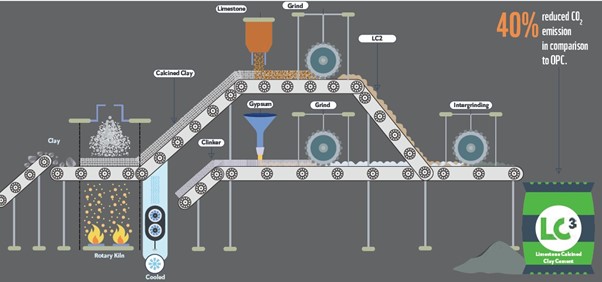Cement is the most widely used building material in the world. It is also a major contributor to global climate change, accounting for around 8 percent of all anthropogenic carbon dioxide emissions.
If the cement industry were a country, it would be the third largest carbon dioxide emitter in the world. In 2017, global cement production was 4.133 billion tonnes, and this is expected to increase by up to 23 percent by 2050 driven by population growth and increasing urbanisation.
Recent advances in cement technology, known as Limestone Calcined Clay Cement (LC3), have the potential to substantially reduce both carbon emissions and energy use during cement production, resulting in environmental benefits and cost savings for producers and consumers, while also maintaining durability and other beneficial physical properties.
What is Limestone Calcined Clay Cement (LC3)?
LC3 or Limestone Calcined Clay Cement is a family of composite cements containing Portland clinker, calcined clay and limestone. The LC3 technology promises a sustainable growth of economies around the world by reducing up to 40% CO2 emission compared to Ordinary Portland cement at lower investment and production costs. LC3 uses raw materials and technologies that are already used by the cement industries. The production process is similar to the way of producing normal cements. Thus they provide a practically viable solution to improve sustainability in the cement industry.
The LC3 Technology has been developed and disseminated by a consortium of researchers and technology incubators led by Professor Karen Scrivener from Ecole Polytechnique Federale De Lausanne, Switzerland. The main partners include the Central University Las Villas in Cuba and, in India, the Indian Institutes of Technology Delhi (IITD) and Madras (IITM), as well as Technology and Action for Rural Advancement (TARA). The LC3 initiative globally is supported by Swiss Agency for Development and Cooperation.
The LC3 Feasibility Project in Pacific Small Island Developing States
The aim of this project is to establish a research partnership between The University of Queensland (UQ) and collaborators in India to assess the feasibility of introducing low carbon LC3 cement technology to the cement industry in Pacific Small-Island Development States (SIDS), focusing on the cement industry in Fiji. Through a series of workshops, the collaboration will lead to the development of a detailed feasibility study action plan to be implemented as part of a larger, longer term project aimed at introducing LC3 cement technology to SIDs.

Expected impact
Pacific Small Island Developing States are heavily dependent on the import of key cement materials such as clinker from countries outside of the region in order to meet their increasing construction material needs. At the same time, inconsistent supply of materials commonly leads to acute cement shortages that impede the ability of Pacific Island States like Fiji to rebuild following natural disasters such as cyclones and floods, which regularly impact the region. LC3 technology has the ability to address these shortages by substituting large quantities of imported clinker with locally available kaolinic clays. This has the added benefit of reducing carbon dioxide emissions by as much as 40% compared to Ordinary Portland Cement – a high priority in climate-change vulnerable island states - while also generating new employment opportunities and reducing energy costs.
Project members
Professor Daniel Franks
View Daniel Franks' research profile
Dr Paul Rogers
Senior Research Fellow, Global Centre for Minerals Security
View Paul Rogers's research profile
Project partners
The project is a collaboration between UQ's Sustainable Minerals Institute (SMI), the Australian Institute for Bioengineering and Nanotechnology (AIBN), and two Indian research institutes. Our Indian partners, IITD and TARA, have been at the forefront of efforts to develop and disseminate game changing LC3 low carbon cement technology, and have pilot projects and feasibility studies currently underway in Cuba, Malawi and other countries. Other partners in this project include the Fiji Mineral Resources Department and the Pacific Community (SPC). Industry engagement with cement producers is also underway.
Funding body
This project is being supported by a University of Queensland Global Strategy and Partnerships Seed Funding grant. Funding for a second phase of the project involving implementation of the action plan is being sought from multilateral donors operating in the Pacific.
Contact us
Get in touch to learn more about our project.
Profession Daniel Franks
Director, Global Centre for Mineral Security
The Low-Carbon Cement Adoption in the Pacific Region-Limestone Calcined Clay Cement (LC3) project sits under the Global Centre for Mineral Security (GCMS)
